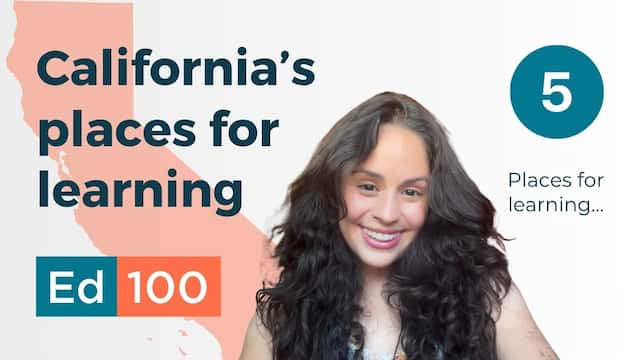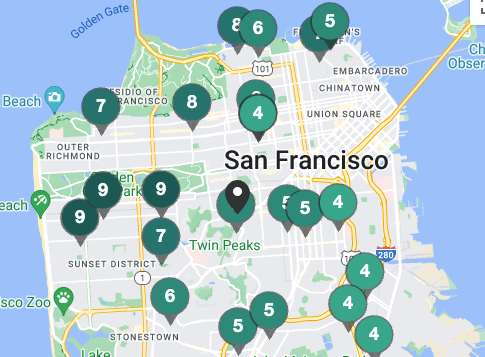
Families are usually told to enroll their kids in the public school nearest their home, but sometimes they have a choice.
In This Lesson

Does school quality affect home prices?
What is a charter school?
What is a magnet school?
What are exam schools?
How do school transfers work?
Where do homeless kids go to school?
What was open enrollment?
What is dual enrollment?
Why does school choice make schools less diverse?Are subsidies a form of choice?
▶
Watch the video summary
★ Discussion Guide
Many families have choices about where their children attend school. This lesson will explain those options, and their limits.
Move for school
High-quality schools and high-value housing go together like bees and honey. For families with enough money to do so, the old-fashioned way to "choose" a public school is to buy or rent housing near it. When a school is perceived as excellent, the value of homes in its attendance area can rise sharply, in a way the St. Louis Federal Reserve describes as non-linear.
Meaningful data about school quality can be hard to come by, so residential property values can be very sensitive to differences in school reputation. Real estate agents often become experts on the local rules that determine school assignment. Changes in those rules can have a direct and rapid impact on a home's value, especially at the high end. Housing developers take note of them, too.
 GreatSchools.org may be able to show you the attendance areas associated with schools of interest to you. The numbers on this map reflect the GreatSchools rating of each school. Click image to visit the site.
GreatSchools.org may be able to show you the attendance areas associated with schools of interest to you. The numbers on this map reflect the GreatSchools rating of each school. Click image to visit the site.
Of course, most families can't afford to buy their way into a great public school neighborhood.
What is a public school of choice?
Some districts allow families to request schools rather than simply assigning students to them. Others won't or can't do so. Why not? Logistics are an often under-appreciated consideration. Many districts are exquisitely awful at keeping track of stuff — including students, teachers, and class records. School information systems can be costly and hard to configure. Rather than risk getting it wrong, some districts find it most practical to just say no.
Charter schools
Charter schools are public schools that operate independently from their school district. About a tenth of students in California attend a charter school. We will explain much more about them in Lesson 5.5, but for now it's sufficient to know that they are open to any student in the district. In places where many families choose to enroll their children in charter public schools, notably Oakland and Los Angeles, districts have developed unified school enrollment systems that include both district schools and charter schools.
Magnet schools
The earliest school choice systems were exceptions. For example, in the 1960s some school districts began creating magnet schools in high-poverty neighborhoods. These schools were meant to attract enrollment by offering something different and attractive — most commonly an unusually rigorous curriculum, or a curriculum oriented toward a particular interest such as art or science. After rapid initial growth, by 2014 these schools had stabilized at less than 1.5% of California enrollment.
Exam schools
School districts in California have created a small number of selective public exam schools (nine, by one estimate). These schools define their attendance area broadly, accepting applicants from throughout their sponsoring district based on grades and test scores. San Francisco's Lowell High School is a prominent example. Other public schools in California with a selective admission process include the Los Angeles School of the Arts and Ruth Asawa School of the Arts in San Francisco, both of which have portfolio and audition elements.
How do school transfers work?
If you want to transfer to a school in a different district, good luck. The obstacles to interdistrict transfers in California tend to be very high compared to other states. The California Department of Education is refreshingly blunt about the state's role in district transfers: None.
"Policies regarding intradistrict/open enrollment and interdistrict/reciprocal agreement transfers are the responsibility of each local district governing board and are not within the jurisdiction of the California Department of Education."
You generally can’t transfer across a district line unless both school districts agree, even though public education in California is mostly state-funded. Like immigration treaties between nation-states, school districts in California negotiate bilateral terms to decide whether particular students that live in their territory may be released from one and accepted in the other. Some districts have joined a temporary, voluntary accord known as the District of Choice program. It suggests policies to minimize bias in the process of accepting and releasing students across district borders.
What about homeless kids?
School enrollment processes in California assume that students have a fixed address, but many don't. Thankfully, there are some rules that protect homeless kids from being kicked out of school, but the rules aren't simple. Learn more about them in the Ed100 blog.
What was the Open Enrollment law?
For a few years, The California Open Enrollment law provided students who were enrolled in any of the state's 1,000 lowest-scoring schools with the right to transfer to any higher-scoring school where seats were available. The law is still on the books, but currently dormant for technical reasons: it was written in a way that relied specifically on the Academic Performance Index (API), a measure that has been eliminated.
More than 20 states claim to have Open Enrollment laws that relax the restrictions on where kids can go to school, at least in certain circumstances. The bar is pretty low for this list — as of 2024, California is still included on it.
California still identifies its lowest-performing schools every year, spurred by federal law. But it does so in a new way and for a more positive reason: the identified schools are eligible for federally-funded assistance programs (CSI and ATSI). California law no longer gives students the right to transfer out of its weakest schools.
What is dual enrollment?
An attractive option available to many high school students is dual enrollment, which allows them to take certain college level classes and earn undergraduate credit for them while enrolled in high school. Learn more about dual enrollment on the Ed100 blog.
School choice is complex. It can make schools less diverse.
It is clear from surveys that families want to have a choice of schools for their kids.
Is school choice bad for diversity?
School districts want to allocate school seats in ways that their constituents will see as fair, but need them to accept the allocation as legitimate. These objectives can be in competition.
Inevitably, preferences require school choice systems to embrace complexity. For example, should there be a preferential advantage for living close to the school? If a family moves, does the advantage change? What if the move is triggered by eviction? Should siblings be automatically enrolled at the same school if they prefer it? Do they each get separate chances in the preference lottery, if there is one? What about children of teachers at the school?
What makes a school popular in a choice system? Experience demonstrates that educational quality matters, but it's complicated, and doesn't necessarily work in ways that school choice advocates might wish. Different schools appeal to families for different reasons, including a sense of fit that can include racial and ethnic affinity. School choice policies can reduce diversity.
Some argue that offering parents a choice of schools is the wrong goal, and not necessarily a good thing on its own for society. Ed100 writer Carol Kocivar explores this question in an online video debate about school choice.
Private schools subsidies marketed as choice
Some families forego public education and enroll their children in religious schools or other private schools at their own expense. Ed100 lesson 5.6 will discuss them.
In Florida and some other states, private schools advocates have successfully lobbied to rebrand private schools as part of the state's "school choice" strategy — at taxpayer expense. California voters have repeatedly rejected proposals to subsidize private schools, most recently through tax-funded instruments called vouchers. There will almost certainly be more attempts to fund private schools using new names like Education Savings Accounts or Tax-Credit Scholarships. We explain these subsidies in Lesson 5.6.
Next up
This lesson focused on the policies and choices that separate and place students into schools. But the practices that sort students go even deeper. The next lesson will look at some of them.
Last updated January 2024.
CHAPTER 5:
Places For Learning
-
Places For Learning
Overview of Chapter 5 -
Where Are the Good Schools?
Zip Codes and School Quality -
School Choice
Policies for Placing Students -
Selective School Programs
How Schools Sort Students -
Continuation Schools
When Regular School Doesn't Cut It -
Charter Schools
Public Schools, Different Rules -
Private Schools
Tuition, Vouchers, and Religion -
Community Schools
Services Beyond Classwork -
Principals and Superintendents
The Pivotal Role of an Educational Leader -
School Facilities
What Should a School Look Like? -
School Climate
What Makes a School Good? -
Small Schools
Are They Better? -
Home Schools
How Do They Work? -
School Discipline and Safety
Suspensions and Other Options
Related
Sharing is caring!
Password Reset
Search all lesson and blog content here.
Login with Email
We will send your Login Link to your email
address. Click on the link and you will be
logged into Ed100. No more passwords to
remember!

















Questions & Comments
To comment or reply, please sign in .
Carol Kocivar December 28, 2024 at 5:39 pm
http://nepc.colorado.edu/publication/finance-equity
Jeff Camp - Founder November 1, 2024 at 2:23 pm
Bruce Ross April 8, 2024 at 3:13 pm
Appeals of transfer denials in turn go to the relevant county board of education. In some counties, it has been a long-standing local board policy that they'll overturn any denial, and so districts realize they don't really have a choice in the matter. (Most districts welcome new students these days. Obviously that's not always the case in basic-aid districts.)
Shasta County and Siskiyou County are effectively open-enrollment, among districts, and superintendents who try to buck this local custom are quickly put in their place. Can't speak to other jurisdictions, but I am surprised it's not an approach county board candidates take elsewhere, when they are interested in promoting new options for parents.
Jeff Camp - Founder March 19, 2024 at 10:41 pm
Selisa Loeza October 23, 2021 at 11:05 pm
For example: My children’s attendance school has a dual-immersion program available. This is a choice for us to enter. However, if we were more interested in the STEM focused elementary school in the district, we would have the right to apply. And the same vice-versa.
Carol Kocivar January 14, 2018 at 10:34 am
"Evidence shows that simply providing choices does not automatically provide high-quality options that are accessible to all students or improve student learning."
The report describes the range of high-quality education options within the public sector and considerations for policymakers as they seek to expand those options. It also lists considerations for policymakers when looking at ways to support private school options that ensure good student outcomes, appropriate uses of fund, and democratic goals.
Read the Report:
Expanding High-Quality Educational Options for All Students: How States Can Create a System of Schools Worth Choosing
Carol Kocivar July 19, 2017 at 2:53 pm
Commentary and research on school vouchers continue to pile up. Here are two:
More Findings About School Vouchers and Test Scores, and They are Still Negative
Evaluation of the DC Opportunity Scholarship Program
"The findings indicate that students receiving and using scholarships had significantly lower
mathematics test scores a year after they applied to the OSP than did students who did not receive a scholarship.
Reading scores also were lower but not statistically significant for the overall sample...
Jeff Camp - Founder July 15, 2017 at 12:48 am
Carol Kocivar July 1, 2017 at 12:42 pm
"While some choice school enrollments are genuinely integrated, the overall body of the re-
search literature documents an unsettling degree of segregation—particularly in charter
schools—by race and ethnicity, as well as by poverty, special needs and English-learner sta-
tus."
Read more here.
Jeff Camp - Founder June 8, 2017 at 9:48 pm
Carol Kocivar January 28, 2016 at 9:31 am
http://lao.ca.gov/Publications/Report/3331?utm_source=subscription&utm_medium=email&utm_campaign=traditional
This report assesses the program and offers recommendations regarding reauthorization.
From the The Legislative Analyst's Office
digalamedabg April 14, 2015 at 8:49 pm